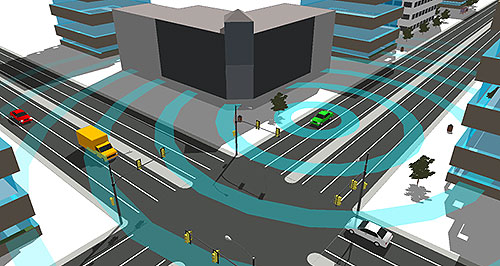News - General News - TechnologyAussie firm leads charge in anti-crash tech testsSecret Cohda: International vehicle-to-vehicle anti-crash technology tests use patented equipment from South Australia company Cohda Wireless. International vehicle-to-vehicle tests using Cohda technology from Oz18 Sep 2012 By IAN PORTER SMALL South Australian company Cohda Wireless is setting the pace in the fast-emerging area of vehicle-to-vehicle communications. The company’s hardware and software has been selected for major vehicle-to-vehicle (V2V) trials in Europe and the United States. The system can warn drivers of another vehicle at a blind intersection – as long as the other vehicle also has a V2V system fitted – or warn that there is an obscured vehicle coming the other way as you are about to pull out and overtake another vehicle on the highway. It also opens the possibility of road authorities installing similar systems on roadside infrastructure to warn of dangerous curves or changed road conditions. Cohda’s equipment has been selected as the only supplier to a major German trial of what is known as Dedicated Short Range Communications (DSRC) technology. The biggest trial of all, involving almost 3000 vehicles in the US, has installed Cohda equipment on 50 per cent of the vehicles being used. Cohda chief executive Paul Gray told GoAuto that his company had developed a solution for the automotive industry from the ground up. “This technology is based on WiFi standards, and everybody else is using off-the-shelf, consumer-grade WiFi chips for their radios,” he said. “Cohda has built something from the ground up – its own WiFi chips – and that leads to significant improvements in performance. “That’s why a small company from Adelaide has really got a lot of traction in these trials happening around the world.” Mr Gray said a typical crash-avoidance situation would involve one car driving down a street towards an intersection. The DSRC equipment could detect a second car (also fitted with DSRC) approaching the intersection on the intersecting road, traveling too fast to stop in time. The DSRC system would set off a warning in both cars, alerting the drivers to a potential crash. However, Mr Gray said Cohda’s system would give the warning a lot earlier, even with a building on the corner. “You can’t see the other vehicle because of a building in the way or it’s on the other side of a truck,” he said. “That’s the scenario where Cohda’s performance really shines.” The Cohda website shows that tests have proven the Cohda equipment can connect from about 200 metres away, while rival systems manage only 20 metres. In addition, the Cohda equipment is superior in urban areas and when dealing with blind corners. Tests have shown that, in instances when there is no line of sight between the vehicles, the Cohda equipment can make a connection more than six seconds away, versus less than two seconds for other, off-the-shelf, WiFi chips. “The wireless communications part of it is just a better solution,” Mr Gray said. “That’s the bit that is patented. And it also offers a receive-side improvement so it is actually 100 per cent compliant with the standards and 100 per cent interoperable with the equipment from other vendors. “It’s just that, if you choose Cohda equipment for your car, you’ll get better performance irrespective of what’s been chosen to go into the other car.” And, while DSRC equipment will, in some cases, replace expensive systems like radar, it will not be pricey, Mr Gray said. He said some European manufacturers were already working towards the adoption of DSRC systems in 2015 and, while it was likely to first appear on top-of-the-line models, he thought it would quickly make its way through the market. “But I think it is going to work down pretty quickly. It’s not a $1000 solution,” he said “It’s a $100 solution.” The authorities and the industry were moving at a different speed in the US, he said, where the transport department is managing a trial of 2880 vehicles. Results are expected in the second half of 2013. There are three possible outcomes from the tests, which are being done by the National Highway and Traffic Safety Administration (NHTSA). The first is that more work will be needed. If the tests prove the technology works, then the US National Highway and Traffic Safety Administration could do one of two things. It could make a five-star rating dependent on whether DSRC technology is fitted, or it could just make DSRC technology compulsory for every vehicle."Mr Gray said vehicle to infrastructure (V2I) communications would also play a key role in improving road safety. Drivers could be given signal timing and phasing information from traffic lights creating a “green wave” of traffic. This message could also tell you how fast you need to drive to make the next green light. “You could also receive curve speed warnings where you get downloaded a map highlighting the local dangerous curves so that, when you are approaching the curve it can tell you that you are traveling too fast. “We now have variable speed signs on freeways, but you will be able to get information into your car as well letting you know there’s road works ahead, or what the changed traffic conditions are.” Mr Gray said he believed European car-makers would move first. “Our big focus is in the European market. That’s where things are going to break first,” he said. “We are gearing up for that mass production side of things. We are in the process of raising some further capital to fund that effort.” Cohda has not yet received any orders, or even a request for a quite from any car-makers. “Hopefully that will happen by early 2013.”  |
Click to shareGeneral News articlesResearch General News Motor industry news |














Facebook Twitter Instagram